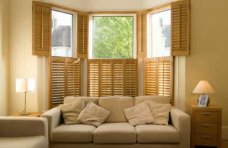“Operable Louvered Shutters”, louvers that are regulated by a tilt rod began to be manufactured around 1830-1840. Before this the louvers were fixed in an open position.
With the advent of the exterior Storm Window in the later 1800’s, shutters were sometimes removed and stored away before the cold months and wooden storm windows would be installed. Removal was easy – all you needed to do was lift the shutter off the pin on the hinge.
Exterior window shutters could also remain on the building, left in an open position. If using storm windows, please note that this was all dependent on the type and mounting of the shutter hinge. It is possible that the storm window would not be able to be inserted into the window jamb if a shutter hinge was in the way.
During the warm months, the storm windows would be removed and window shutters would be closed to protect furniture from the sun and allow outside air to cool the house.
At the end of the Civil War, awnings became popular and window screens began to come into use. Screen windows were just like storm windows except they had screens in the wood frame. In addition to these screen windows, adjustable screens still sold in hardware stores today, or lace curtains also served the purpose. Visit our page on storm windows and window screens.
In some styles of architecture, exterior shutters also began to fall out of fashion. By the 1920’s, although some exterior window shutters were still used for practical reasons, most were strictly decorative.
Those shutters that were purely decorative however, were still functional or had the appearance of being functional. Homeowners could operate the shutter to cool or insulate the home if they wished. There was no difference to the appearance of the house.
Unfortunately, this changed during the 1950’s with the advent of Aluminum Siding and Aluminum Shutters. This is when the dreadful problem we have today began.
Where Exterior Window Shutters Went Wrong
The public has always been in love with the warm cozy feel of a traditional styled home. Exterior wood window shutters provide that look and feel. Aluminum siding and fake aluminum shutters started to be heavily marketed in the 1950s.
To simplify installation of aluminum shutters on aluminum siding, the method of installing exterior window shutters – hanging shutters changed. Window shutters began to be installed by screwing the shutter onto the siding NEXT TO, instead of directly on top of window casing, and without the use of hinges. This was easy and required minimal intelligence.
Eventually, people became more lazy, less knowledgeable, and more insensitive to the appearance of their windows and began using the wrong size shutters. Before you knew it, they were putting rectangular shutters on arched windows and whatever else you could imagine!
This is where we are today. As you may or may not know, the window shutter has evolved in a grossly unfortunate way. Sadly, we too have evolved to accept this new bland look. It is now normal and what we expect to see when we look at a house with shutters. This is also what architects and builders do and what we see with many exterior window shutter companies.












Your relative humidity is too high. Run your exhaust fans longer to reduce the humidity or get a dehumidifier and reduce the humidity to about 30%. If you have a dirt floor in the basement, seal it with plastic to keep the humidity out of the house. At some point old single pane windows will condense with water vapor and there's very little that can be done.